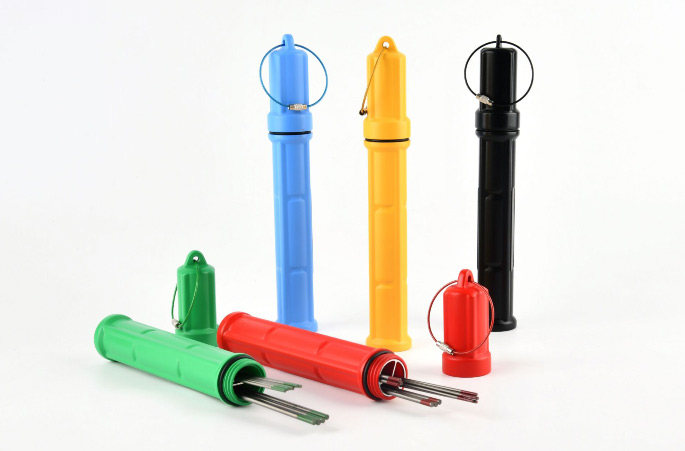Non-consumable tungsten electrodes for GTAW (Gas Tungsten Arc Welding) or TIG (Tungsten Inert Gas) welding, generally are of several types.

Types Of Tungsten Electrodes
Tungsten electrodes types and their typical application can be identified by color-coded end marks as follows.
• Pure Tungsten : Green
• 2% Ceriated : Gray
• 2% Thoriated : Red
• 2% Zirconiated : Brown
• 1.5% Lanthanated : Gold
• 2% Lanthanated : Blue
Pure Tungsten Electrodes
Pure tungsten electrodes are generally used on less critical welding operations than the tungsten electrodes that are alloyed. This type of electrode is used for AC welding, has a relatively low current carrying capacity and a low resistance to contamination.
Thoriated Tungsten Electrodes
Thoriated tungsten electrodes (1 or 2% thorium) are superior to pure tungsten electrodes because of their higher electron output, better arc-starting and arc stability, high current-carrying capacity, longer life, and greater resistance to contamination. 2% thoriated tungsten electrodes can be used for AC welding, but they excel in DC electrode negative (straight polarity) GTAW on carbon and stainless steel, nickel, and titanium.
Welding operators should note that 2% of thoriated tungsten electrodes contain low levels of radioactivity. Therefore, they must always follow the manufacturer’s warnings, instructions, and the MSDS (Material Safety Data Sheet) for their use.
Lanthanated Tungsten Electrodes
Lanthanated tungsten electrodes contain a minimum of 97.80% tungsten and 1.30% to 1.70% lanthanum, or lanthana, both 1.5 and 2% lanthanated tungsten electrodes offer excellent arc starting at low amperages, provide long electrode life and stability, and have a low burn-off rate. They also resist tip wear.
The 2% lanthanated tungsten electrodes are considered to have superior characteristics. 2% lanthanated tungsten electrodes are often used in critical applications, such as in the aviation industry, and can be used to replace 2% thoriated tungsten electrodes. Both electrodes are well suited to welding carbon steel, stainless steel, nickel alloys, titanium, and aluminum.
They work well on AC or DC electrode negative (DCEN) with a pointed end, or they can be balled for use with AC sine wave power sources. Unlike thoriated tungsten, lanthanated electrodes are suitable for AC welding and, like ceriated electrodes, allow the arc to be started and maintained at lower voltages.
Compared with pure tungsten, the addition of 1.5% lanthana increases the maximum current-carrying capacity by approximately 50% for a given electrode size.
Ceriated Tungsten Electrodes
Ceriated tungsten electrodes contain a min of 97.3% tungsten, with 1.8 to 2.2% cerium, are used for low current settings, and have a low-amp arc. These electrodes perform best in DC welding at low current settings but can be used proficiently in AC processes.
Zirconium Tungsten Electrodes
Zirconium tungsten electrodes contain 0.7–0.9% zirconium and are known for their ability to ball up easily in AC applications. Zirconium electrodes generally fall between pure tungsten electrodes and thoriated tungsten electrodes in terms of performance. There is, however, some indication of better performance in certain types of welding using the ac power.
How To Select Tungsten Electrodes?
The selection and preparation of tungsten electrodes for TIG Welding or Gas Tungsten Arc Welding (GTAW) to use for a particular application depends on many variables, including the type of material to be welded, the welding amperage, and the type of weld, among other factors.
Tungsten Electrode Diameters And Lengths
Tungsten Electrodes are available in a variety of standard diameters and lengths.
The most common length is 7.00” (175 mm). Tungsten is usually supplied in boxes of 10 pieces.
